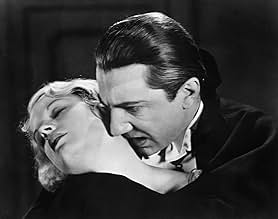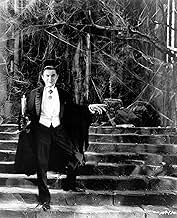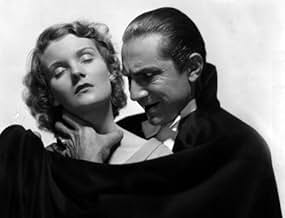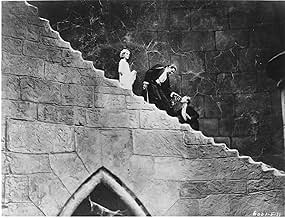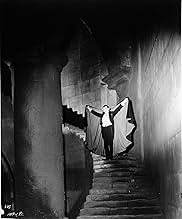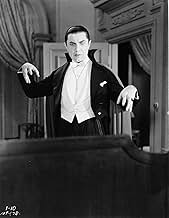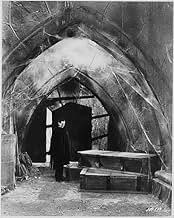IMDb-BEWERTUNG
7,3/10
62.577
IHRE BEWERTUNG
Der alte Vampir Graf Dracula kommt in England an und stellt dort der tugendhaften jungen Mina nach.Der alte Vampir Graf Dracula kommt in England an und stellt dort der tugendhaften jungen Mina nach.Der alte Vampir Graf Dracula kommt in England an und stellt dort der tugendhaften jungen Mina nach.
- Auszeichnungen
- 5 Gewinne & 3 Nominierungen insgesamt
Charles K. Gerrard
- Martin
- (as Charles Gerrard)
Anna Bakacs
- Innkeeper's Daughter
- (Nicht genannt)
Bunny Beatty
- Flower Girl
- (Nicht genannt)
Nicholas Bela
- Coach Passenger
- (Nicht genannt)
Daisy Belmore
- Coach Passenger
- (Nicht genannt)
William A. Boardway
- Concertgoer Outside Theatre
- (Nicht genannt)
Barbara Bozoky
- Innkeeper's Wife
- (Nicht genannt)
Tod Browning
- Harbormaster
- (Synchronisation)
- (Nicht genannt)
Moon Carroll
- Maid
- (Nicht genannt)
Geraldine Dvorak
- Dracula's Wife
- (Nicht genannt)
Empfohlene Bewertungen
(62%) It is without doubt a classic owing to the fact that it is so well made, and so memorable. The sets are some of the greatest ever to appear on any film, and Lugosi is great as the awful head vamp. It's more than a little dated of course, so there's no blood/biting or on-screen death or murder, plus the acting is very theatrical at times, and there's quite a few long drawn-out sections of total silence that highlight exactly how old and pioneering it is.With that said, all horror fans should watch this at least once, as it does make a great late-night Halloween movie that will live on - just like the old count himself - forever.
Bela Lugosi forever captures the role of a certain undead Transylvanian count who takes a trip to London in the first legitimate version of the classic Bram Stoker novel. Despite many attempts by many talented film makers, I believe this version, directed by Tod Browning, remains the definitive take on the often-filmed novel. But why? Is it simply nostalgia? Granted, I do fondly remember staying up late as a child watching this film on Ghost Host theater and finding myself suitably frightened. However, if I were the same age today, would I find the film as effective? Would a steady diet of more modern and explicit horror films made me too jaded to enjoy the more subtle charms of this film? I hope not, but I could see how it might. The film is slow, and its slowness is further emphasized by the absence of an under score. It is stagey - being as it was more influenced by the stage play than the novel itself. Also, the story plays itself out too quickly. Van Helsing manages to figure everything out and dispatch the count in about two seconds. There simply isn't much suspense - and even less gore or violence. Yet it remains the champ. Why? The main reason is Lugosi himself. He gives the performance of a lifetime. He truly inhabits the role and is genuinely creepy. The rest of the cast, particularly Edward Van Sloan as Van Helsing and Dwight Frye as Renfield, support him admirably. However, when I watch the old Universal horror films nowadays, I find myself really enjoying the atmospheric sets and lighting. Yes, there is still much to love about Dracula today. (As long as you avoid the optional Philip Glass score on the DVD!)
It's almost impossible not to love 'Dracula', a horror milestone that is the most important and influential vampire movie ever made. Bela Lugosi became a cinematic legend after this movie, and his portrayal of Dracula basically invented the modern vampire as we know it. Murnau's silent classic 'Nosferatu' was an obvious influence on Todd Browning, but while Browning was no James Whale (the innovative British director who made 'Frankenstein' for Universal a few months after this) he added a lot of his own style and ideas to the project, and Counts Orloff and Dracula are completely different kinds of creatures. Lugosi made his Count sophisticated, attractive and sexy, and this is what made this movie such a sensation at the time, and what helps make it still a wonderful viewing experience. Lugosi's performance is one of the greatest in horror history. Some of the other actors in the cast are a bit shaky but Edward Van Sloan as Van Hesling is excellent and Dwight Frye's Renfield (a different character from the book) is also memorable. Both actors would reappear in 'Frankenstein'. 'Dracula' is an important landmark horror movie, but even better, is still a fantastic viewing experience seventy years later. Don't just watch it because it's a classic, watch it because it's wonderful entertainment!
Dracula is a figure that is known by virtually all and can be credited in large part to this 1931 classic. Bela Lugosi who plays Count Dracula is horrifyingly creepy and finding a better Dracula would be nearly impossible. From the first encounter between Renfield and Dracula to the closing scene, the audience is on the edge of their seats and don't know what to expect, which is an essential part of most horror movies. I was a big fan of this film not only because it is an American classic but because it is a true horror film. In my opinion, too often in horror films today, the story itself isn't scary at all. The experience of going to the movie theatre with a huge screen and incredibly loud speakers help scare audiences by having things pop out when you are least expecting it. I believe that anyone can make a movie like that and is completely insignificant. The story behind Dracula is truly creepy and horrifying. A great story like this makes this one of the most significant horror films in history.
... and that explains all of the differences, such as Renfield being the person to visit Dracula in Transylvania to seal a real estate deal rather than Jonathan Harker.
I imagine this was quite the spectacle in 1931. Visually it still is - sweeping staircases, ruined old castles covered in dust, moonlight illuminating giant spiderwebs, coffins with limbs hanging out of them, rats scurrying about. And Bela Lugosi, who starred in the Broadway play, was dying to play the lead. But director Tod Browning was set on Lon Chaney, a frequent collaborator, playing both Dracula and Van Helsiing.
It's not true that everybody is replaceable, but it IS true that eventually an irreplaceable person will no longer be around and a perhaps less than ideal work-around must be found. This was the situation with Chaney - a unique actor who could convince you he was anybody. He died before Dracula was filmed. Lugosi successfully lobbied for the part, although he did so at a cut rate. Today his old world hypnotic presence is synonymous with the role.
But I have to admit I have an unpopular opinion. To me Dracula seems very slow and very much "early talkie" in personality when compared to the film Frankenstein of just a year later. Also, like many early talking films that were not musicals, there is no score.
And I have to wonder about director Tod Browning. Although this was Browning's biggest hit, his other enduring works all starred Lon Chaney. He only directed a few more films and disappeared from the industry for a quarter of a century until his death. He had a disappearing act worthy of Universal Horror.
Things to watch for - Armadillos in Transylvania? Probably far too cold for them there. David Manners and Helen Chandler as young lovers Jonathan Harker and Mina - They have all of the chemistry of two cardboard boxes. Why did they keep pairing these two in films? Dwight Frye as Renfield - did Frye EVER get to play a normal person? And why would he want to be sent away? He gets to wander in and out of the lush living quarters of the superintendent f the mental facility. He wouldn't get that freedom anywhere else. And last but not least, Carla Laemmle, unrecognizable as a tourist, reading from a Transylvania tour guide.
I imagine this was quite the spectacle in 1931. Visually it still is - sweeping staircases, ruined old castles covered in dust, moonlight illuminating giant spiderwebs, coffins with limbs hanging out of them, rats scurrying about. And Bela Lugosi, who starred in the Broadway play, was dying to play the lead. But director Tod Browning was set on Lon Chaney, a frequent collaborator, playing both Dracula and Van Helsiing.
It's not true that everybody is replaceable, but it IS true that eventually an irreplaceable person will no longer be around and a perhaps less than ideal work-around must be found. This was the situation with Chaney - a unique actor who could convince you he was anybody. He died before Dracula was filmed. Lugosi successfully lobbied for the part, although he did so at a cut rate. Today his old world hypnotic presence is synonymous with the role.
But I have to admit I have an unpopular opinion. To me Dracula seems very slow and very much "early talkie" in personality when compared to the film Frankenstein of just a year later. Also, like many early talking films that were not musicals, there is no score.
And I have to wonder about director Tod Browning. Although this was Browning's biggest hit, his other enduring works all starred Lon Chaney. He only directed a few more films and disappeared from the industry for a quarter of a century until his death. He had a disappearing act worthy of Universal Horror.
Things to watch for - Armadillos in Transylvania? Probably far too cold for them there. David Manners and Helen Chandler as young lovers Jonathan Harker and Mina - They have all of the chemistry of two cardboard boxes. Why did they keep pairing these two in films? Dwight Frye as Renfield - did Frye EVER get to play a normal person? And why would he want to be sent away? He gets to wander in and out of the lush living quarters of the superintendent f the mental facility. He wouldn't get that freedom anywhere else. And last but not least, Carla Laemmle, unrecognizable as a tourist, reading from a Transylvania tour guide.
Wusstest du schon
- WissenswertesGenerally regarded as the film that kickstarted the horror genre in Hollywood.
- PatzerIn the scene where Van Helsing is attempting to catch Dracula's lack of reflection in a mirror, there are visible chalk marks on the floor showing Bela Lugosi where to stand for the shot.
- Zitate
Count Dracula: This is very old wine. I hope you will like it.
Renfield: Aren't you drinking?
Count Dracula: I never drink... wine.
- Crazy CreditsThe original title card has producer Carl Laemmle, Jr. identified as Presient (sic).
- Alternative VersionenA version of the film played on the 10/24/15 airing of Svengoolie (1995) featured a soundtrack taken from the French language audio track on the Dracula Blu-ray.
- VerbindungenAlternate-language version of Dracula (1931)
- SoundtracksSwan Lake, Op.20
(1877) (uncredited)
Music by Pyotr Ilyich Tchaikovsky
Excerpt Played during the opening credits
Top-Auswahl
Melde dich zum Bewerten an und greife auf die Watchlist für personalisierte Empfehlungen zu.
Details
- Erscheinungsdatum
- Herkunftsland
- Offizieller Standort
- Sprachen
- Auch bekannt als
- Drácula
- Drehorte
- Produktionsfirma
- Weitere beteiligte Unternehmen bei IMDbPro anzeigen
Box Office
- Budget
- 355.000 $ (geschätzt)
- Weltweiter Bruttoertrag
- 87.019 $
- Laufzeit
- 1 Std. 15 Min.(75 min)
- Seitenverhältnis
- 1.20 : 1(original release)
Zu dieser Seite beitragen
Bearbeitung vorschlagen oder fehlenden Inhalt hinzufügen


